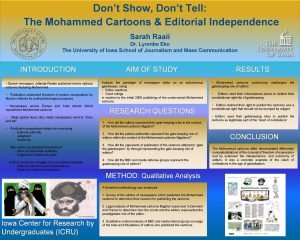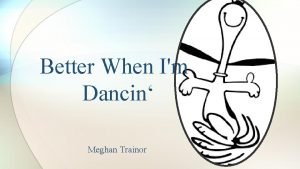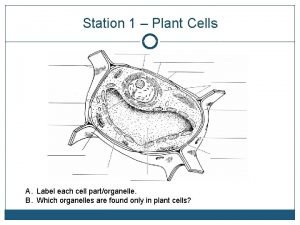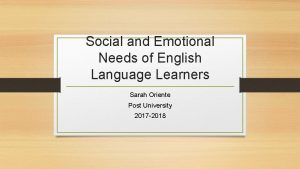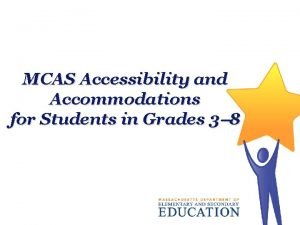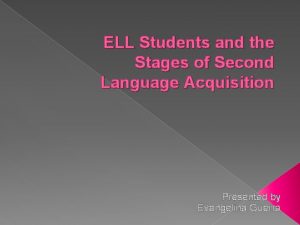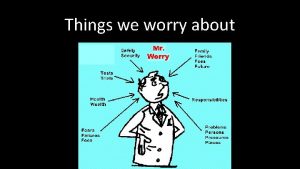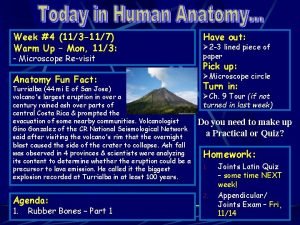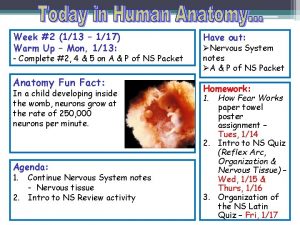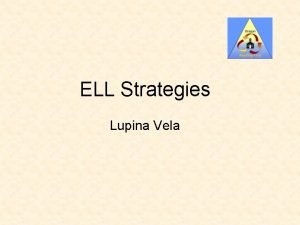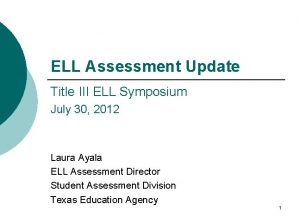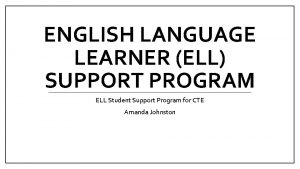ELL 113 Week 4 Dont worry its just























- Slides: 23

ELL 113 Week 4 Don’t worry, it’s just a phrase THE PARTS OF SYNTAX

2 Heads and phrases • In Now that we two have the tools to learned identifyhow where the previous weeks, students to define different like categories of wordsdeterminers, appear, we start to categories nouns, adjectives, andcan verbs based represent them structurally. on their distribution in the sentence. • Selection Each word isnotion the head of a phrase, and because is the of immediate locality or are ‘sisterhood’ phrases based in onsyntax their and heads, they come in the morphology. same categories that words do! • Each head will have certain selectional properties Selection helps explain to students thatsyntactic determine of the phrase. why treesthe are characteristics binary.

3 Heads and phrases • Noun phrase (NP): happy boy • The type of noun determines what kind of adjectives it can be modified by (*happy table). • Determiner phrase (DP): the boy • Different determiners select different types of nouns (the sand, *a sand) • Prepositional phrase (PP): on the table

4 Heads and phrases • Verb phrase (VP): quickly eat a cake • Different verbs require different numbers of arguments ‘swim’ is a verb that takes one argument (swimmer) ‘eat’ takes two arguments (eater and eatee). ‘give’ is a verb that takes three arguments (giver, givee, and the thing being given) • Different verbs can be modified by different types of adverbs (*quickly have a car)

5 Heads and phrases • Tense phrase (TP): will eat a cake. • Communicates the temporal setting of the event.

6 Heads and phrases • In English, phrases are head-initial, meaning that the head (underlined) comes before the material it selects, called the complement (italicized) • • VP: see the boy with the headband DP: The boy with the headband NP: boy with the headband PP: with the headband

7 Introducing Constituency • Many Phrases are chunky. syntax textbooks introduce tree drawing through phrase structure rules. • Some sequences can be repeated over and over again S NPI saw (aux)the VPbook NP IDet saw(Adj) the N book [on the chair] VP IVsaw (NP) (PP) the book [on the chair] [in the library] I saw the book [on the chair] [in the library] [on the hill] • What sequence is repeating? Preposition – Determiner – Noun (PDN)

8 Introducing Constituency • It’s not possible to repeat just PD or DN *I saw the book [the chair] *I saw the book [on the chair] [in the] • Why can only certain structures repeat? • Just as morphemes combine hierarchically to form words, words combine hierarchically to form constituents. • A constituent is a string of words that speakers can manipulate as a single unit.

9 Constituency tests • In order to find constituents, syntacticians use constituency tests. • If a string of words is a constituent, then we will treat it as if it is one unit in our hierarchical structure of the sentence

10 Constituency tests • You will notice that many of our constituency tests identify individual phrases as units • Sometimes, a phrase IS a constituent • Sometimes, constituents consist of more than one phrase How many phrases can you identify in “on the chair”?

11 Test 1: Substitution • Substitution involves replacing an entire string of words with a single word that keeps the meaning of the sentence the same. This girl in the red coat will put a picture of Bill on the desk she

12 Test 1: Substitution • The girl in the red coat she • What type of phrase is the pronoun ‘she’ substituting for? • Hint: What word is the head of the phrase? The head determines the type of phrase.

13 Test 1: Substitution a picture of Bill This girl in the red coat will put on the desk it This girl in the red coat one will put a picture of Bill on the desk • What types of phrases do ‘it’ substitution and ‘one’ substitution identify?

14 Test 1: Substitution are often very about(he, how she, to classify a you • Students Replacement withconfused a pronoun it) tells proper that name. the string you are a replacing is a DP constituent ate cake She ate cake • Susan Replacement with ‘one’ tells DP yousubstitution that the string you are replacing is an NP constituent Names must be DPs, but students often want them to be nouns • Make sure when you go to use this test, you are (person, place, or that thing…) thinking of the noun version of ‘one’, which can be pluralized (I want the red ones), rather than the This isnumeral where the distributional tests useful: one, which can’t (*I are have ones dog) Susan = the girl five Susans = five girls

15 Test 1: Substitution • One replacement can occur with NPs of different sizes! • The pretty red coat That pretty red [one] (=coat) That pretty [one] (=red coat) That [one] (=pretty red coat) discussion students up to learn about the ideacoat of • This What mustsets the structure of pretty red adjuncts, be? which occurs in the following week.

16 Test 1: Substitution • Because adjectives modify nouns, they appear inside the NP, at the very edge. • This is part of why you can have as many adjectives as you want—they modify the noun instead of being selected by it directly. • How do we know they aren’t selected? They aren’t necessary. • This is also why they occur before the noun, even though English is head initial.

17 Test 1: Substitution Redacted: Substitution tests for PP (there) and VP (do so), followed by a second time of constituency test (deletion). In the second year Syntax course (ELL 221), students learn several more constituency tests, some of which let them identify types of phrases that aren’t discussed here.

18 Constituency tests: The take home message • The logic behind constituency tests is that any time a string of words can behave as if it is a single unit, then it must BE a single unit.

19 Practice • This beautiful big blue blanket will cover that couch in the room nicely. This sentence seems incredibly daunting at first, but with the distributional tests from Week 3 and the constituency tests from this lecture, students can actually build every part of the tree except the very top, which they will learn about the following week. Plus, they can explain why the structure is that way.

20 • this beautiful big blue blanket = it = DP • beautiful big blue blanket = one = NP • blanket = one = NP 10/28/2020 © The University of Sheffield

21 • Cover that couch in the room nicely= do so = VP • Cover that couch in the room = do so = VP • that couch in the room = it = DP • couch in the room = one = NP • couch = one = NP • In the room = there = PP 10/28/2020 © The University of Sheffield

22 Putting it together • In the first year course, the students aren’t taught the constituency tools to figure out how to represent the subject, Tense and Verb Phrase in a binary way. Instead, we ask them to (temporarily) memorize and use this structure: 10/28/2020 © The University of Sheffield

23 Further resources • www. allaboutlinguistics. com • An Introduction to Syntactic Analysis and Theory – Sportiche, Koopman, and Stabler • Current text for ELL 113 Structure of English (Chapters 2, 3. 1 -3. 5) and ELL 221 Syntax (Chapters 3 -8) • An Introduction to Language (10 th edition) – Fromkin, Rodman, and Hyams • Chapter 3 is a fairly accessible introduction to 10/28/2020 syntactic © The University of Sheffield structure.
 Dont worry be happy notes
Dont worry be happy notes Dont worry be ready
Dont worry be ready Dont ask dont tell political cartoon
Dont ask dont tell political cartoon Dont laugh at me dont call me names
Dont laugh at me dont call me names Dancing yeah yeah ba ba ba
Dancing yeah yeah ba ba ba Ell specialist
Ell specialist Karina ell
Karina ell Plant cell
Plant cell Karina ell
Karina ell Social emotional needs of ell students
Social emotional needs of ell students Karina ell
Karina ell Plant cell
Plant cell Karina ell
Karina ell Karina ell
Karina ell Mcas universal accommodations
Mcas universal accommodations Stages of ell
Stages of ell Ell student profile
Ell student profile Karina ell
Karina ell Karina ell
Karina ell Ell 101
Ell 101 Week by week plans for documenting children's development
Week by week plans for documenting children's development In scene 2 what is friar john's excuse
In scene 2 what is friar john's excuse Never_used
Never_used Where was don't you worry child filmed
Where was don't you worry child filmed


